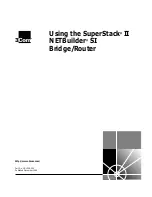
Phoenix G2 IDU User Manual
WEB GUI
SAF Tehnika JSC
58
5)
Step 5
– save configuration by pressing
button.
Management channel configuration options
There are several options for accessing the remote side management from or via local device:
In-Band management
o
User data and management data share the common link capacity and are
separated by a VLAN
Out-of-Band management
o
Using internal management channel (NAT) through separate management
channel
o
Management alone in a separate traffic channel
In-Band Management
In-Band management configuration with management traffic separation by means of VLAN is
a preferred scheme when just one ETH connection (management & data traffic) into
microwave link is accomplished. Communication with the remote side is ensured by sharing
the capacity for data and management traffics through internal ETH switch. The management
data together with the user data are brought via the common Gigabit cable from the external
Ethernet switch to the device, and the same VLAN is then used in the whole management
network for management traffic separation. For Port group and VLAN configuration refer to
The advantages of such option are following:
Fast management access to local and remote device
Just one Ethernet cable is required for data and management traffic connection
The disadvantages of such option are following:
Management traffic shares capacity with the data traffic
It is required to know what is the type of customer traffic, especially VLAN
configuration at provider and customer side
Out-Band Management
1)
Using Internal Management Channel (NAT)
:
Out-Band management configuration with NAT is a preferred scheme when just one
link is supervised and management access is originated from provider side of the link.
Management and data traffic must be separated at provider side in this mode.
Communication with the remote side is ensured through fixed internal management
channel. Management traffic is routed through management CPU inside the device.
The device has an option to auto-configure the NAT setting under section
For the NAT auto-configuration it is possible to enable one or both of these options:
a)
WEB
– this option will add automatic NAT records for accessing the remote
device’s WEB GUI. The default values are as follows (the IP portion is only an
example and depends on actual running IP configuration):
1443 192.168.3.91:443 Remote IDU’s GUI accessible on local port 1443
2443 192.168.3.92:443 Second remote (in 505 1+0 dual mode with two
separate remotes) or direct FO neighbor (in Split
Protection mode) IDU’s GUI accessible on local port
2443
3443 192.168.3.93:443 Indirect remote FO neighbor (ergo 'cross-corner' in split
protection mode) IDU’s GUI accessible on local port
3443















































